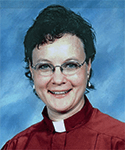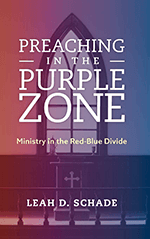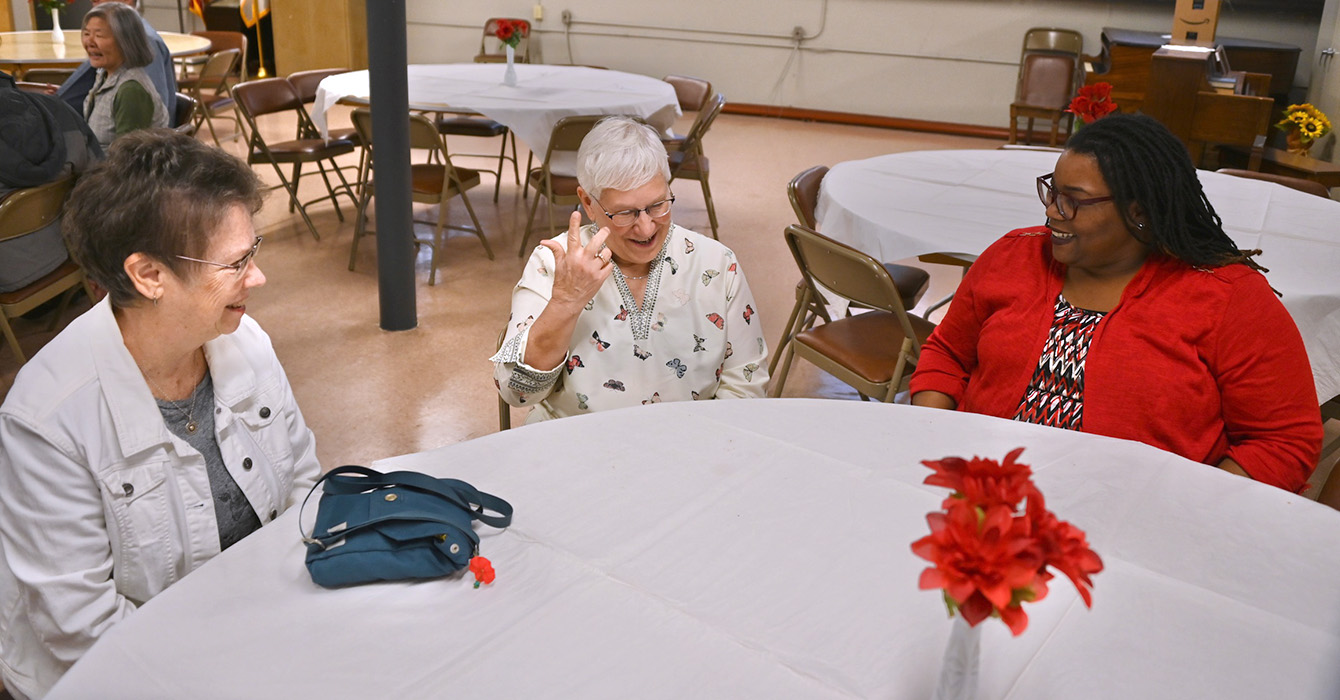Editor's note: This is one in a series of pieces from a variety of perspectives addressing the 2020 election.
When Leah Schade heard that congregations were experiencing unprecedented division in the lead-up to the 2016 election, she wanted data.
 In early 2017, she designed a survey to hear how mainline Protestant pastors were dealing with the hot-button issues of the time -- and how their congregations were reacting. Some 1,200 pastors responded.
In early 2017, she designed a survey to hear how mainline Protestant pastors were dealing with the hot-button issues of the time -- and how their congregations were reacting. Some 1,200 pastors responded.
Among her findings was that most pastors leaned more progressive than their congregations and were searching for positive ways to address an increasingly partisan divide. She wrote about her research and how clergy and congregations can learn to engage “hot” topics constructively in a book published last year, “Preaching in the Purple Zone: Ministry in the Red-Blue Divide.”
Schade advocates a method of preaching and dialogue that addresses the political differences in a church instead of avoiding them -- a crucial aspect of the work of Christians, she says, especially with another election looming.
 She is an ordained minister in the Evangelical Lutheran Church in America and an assistant professor of preaching and worship at Lexington Theological Seminary. A longtime advocate for environmental and social justice issues, she is also the author of the 2015 book “Creation-Crisis Preaching: Ecology, Theology, and the Pulpit.”
She is an ordained minister in the Evangelical Lutheran Church in America and an assistant professor of preaching and worship at Lexington Theological Seminary. A longtime advocate for environmental and social justice issues, she is also the author of the 2015 book “Creation-Crisis Preaching: Ecology, Theology, and the Pulpit.”
She spoke with Faith & Leadership’s Chris Karnadi about her most recent book, how pastors can broach sensitive political topics with their congregations, and how the coronavirus has affected political divides. The following is an edited transcript.
Faith & Leadership: What did your survey find were some of the main worries that pastors were having in dealing with politics from the pulpit?
Leah Schade: The main worries of the pastors boiled down to four basic fears. One was a fear of being seen as too political and thereby not having the trust of the congregation to be a neutral arbiter of these issues.
Another was a fear of inadequacy, not feeling like they were equipped to talk about issues that they really were qualified to speak to. I think a lot of pastors worry about being accused of speaking about issues when they don’t know all the facts. So there’s some concern of either not being equipped or not being effective and maybe making a situation worse by bringing up a controversial issue and then its becoming more divisive.
Another was a fear of loss, that if people are angry about a pastor bringing up a topic, they may threaten to leave the church or withhold their money or sow division in some way. There are some pastors who fear losing their jobs because they might get pushback.
The other was a fear of losing effectiveness in their pastoral role. For example, if somebody is angry at a pastor for, let’s say, preaching about immigration, and they’re so angry that they won’t even call the pastor when they’re scheduled for surgery, that’s a problem. Pastors do not want to sacrifice their pastoral role while they are answering their prophetic role.
F&L: From your survey, did you find that most congregations are “purple” instead of just blue or red?
LS: The data backs up other studies that have shown that mainline Protestant clergy tend to be more progressive, moderate to progressive, while their congregations tend to be more moderate to conservative.
There is a purple zone between the pastor and the congregation, and then congregations themselves usually have a spectrum of red and blue. This is not to say that American politics can be boiled down to just these two colors, so to speak, but this is the color metaphor that we’ve been given, so that’s what we’re working in.
The point that I make in the book is that no matter where you fall personally in your own understanding of politics, you have to be the pastor to everyone.
So how do we find a way to be faithful to our call to preach the gospel and not alienate our parishioners in the midst of that? How do we find a way to build bridges of community instead of exacerbating cracks and divisiveness?
F&L: You propose a sermon-dialogue-sermon method. Can you talk about that?
LS: There are different ways to approach preaching social issues. One is just to avoid it altogether, and I will say that nearly 25% of those who answered this question in the survey said that they either rarely or never addressed any social issues in their preaching.
Another option is a very strident and strong voice for justice, to be more in-your-face with the congregation and say, “Look folks, we’ve got an issue with racism in our community and it’s not biblical, and we need to do something about this.”
The danger with that is if a congregation has not been prepared ahead of time, it can create a negative situation for the pastor, where people react negatively. They can walk out or send emails or something else more drastic. Even though what the pastor is doing is done with the best of intentions, there may be unintended consequences.
I wanted to find something between these two extremes, and what I heard a lot of people say in the survey is that one of the reasons they’re uncomfortable with addressing social issues in the pulpit is because it’s just their voice talking. There’s no opportunity for feedback during the sermon, so it can feel like the pastor is imposing their views on the congregation.
This sermon-dialogue-sermon method that I developed is finding a way to thread the needle, so to speak. The first sermon is a prophetic invitation to dialogue, where a pastor would not take a stand on a particular issue but merely raise it as something that we can talk about and then plan a time and place for the congregation to talk through it.
The dialogue is based on a course that was developed by the Kettering Foundation. In the dialogue, people first share how an issue has impacted them and then look at three different approaches to a topic, whether it’s the opioid crisis or mass shootings or climate change. The group weighs the pros and cons to each approach, which helps develop some critical thinking skills and also empathy for those who might have a different viewpoint than what each individual might have.
Then the group identifies some common values and some shared ground as they realize that they have different perspectives but can agree that, say, fairness is very important to all of us, or protecting children is really important.
Now, that might look different for my conservative friends as compared with my progressive friends, but just naming that we share this in common is really important. Then the congregation can decide on next steps based on these shared values while recognizing their diverse perspectives.
The follow-up sermon is what I call the communal prophetic proclamation. It’s communal because the pastor has been listening to these conversations, and when they speak about the issue, they’re not saying “thus says the pastor.”
They’re saying, “This is what we discerned. This is how the Spirit was moving among us in our conversation, and this is where we feel God is calling us to move forward on this issue.” That helps frame the discussion biblically and theologically.
As the church, we’re uniquely situated, because we already gather people from different constituencies, of different ages, from different walks of life, different socioeconomic positions, to do things together like gather for worship, like serve our neighbors, like learn together to build a living faith.
We already have the spiritual and scriptural and ecclesial resources to do this, so we can be like laboratories for helping people explore what it looks like to find common ground and to build on the wisdom of the group for addressing these very important issues that affect all of God’s people.
F&L: Are there limits to the ability to dialogue? For example, what happens when someone questions another’s humanity?
LS: In a dialogue, everyone should be equal. That’s the premise. But if you have somebody there who invalidates the very personhood of someone else by their race, ethnicity, immigration status or gender or sexuality, then you put people in an even more vulnerable situation.
One of the ways that we address that is to establish really clear ground rules about how we will treat each other, and the group has to agree to these ground rules. One of those is to be very intentional about speaking “I” statements and not making mountaintop declarations about any group of people.
When I hear those broad blanket statements, there are often personal stories behind them, and talking it through within the boundaries of respectful conversation can help us have those difficult discussions in a way that unearths the pain. What are the pain points that are informing this?
The other thing we found is that there are certain individuals who are hesitant to come to the dialogue in the first place. For example, those who do tend to be more conservative are inherently suspicious of any dialogue, because they assume that they are being expected to change their minds about an issue.
It’s really important to help people understand that this is actually not about changing anybody but about meeting and listening deeply to each other.
F&L: How is it more difficult to engage political polarization with many services now online?
LS: I suspect that divisiveness within congregations is being muffled or muted during the coronavirus, because people aren’t physically together -- but also because the need for care outweighs political differences. Being members of the body of Christ in the time of a pandemic means that people are prioritizing compassion above all.
At the same time, the presidential election is still looming on the horizon. The issues of public concern that existed before the pandemic have not gone away. In fact, things like income inequality, access to medical care, domestic abuse, the opioid crisis and hunger issues have been exacerbated and brought into sharp relief by the pandemic.
So it will be important for clergy and lay leaders to find ways to help their congregations talk about these issues, even if it has to be through an online format.
This is actually an exciting time for deliberative dialogue. I’ve been experimenting with different ways to conduct these dialogues in an online format. One is through a platform called Common Ground for Action (CGA), developed by the Kettering Foundation. It’s a gamified format where people log on to an online forum that is moderated and generally lasts about two hours.
I’ve also been moderating a deliberative dialogue over a series of weeks in another class I’m teaching. We use discussion boards to move through each stage of the dialogue, and I record and track the conversation through a Google Doc. This allows people to sign on anytime during the week, take their time to think about their responses, and have more space to explore and discuss the topic with their peers.
I’m encouraging my ministry students and pastoral colleagues to experiment with these different online platforms in their congregations. While we miss being together in person, there are several advantages to an online platform. For example, people can join from their homes as long as they have a good internet connection. Those who might be more reticent at an in-person event often open up more in a text-based forum.
As we move deeper and longer into this pandemic, I encourage clergy and lay leaders to find ways to help their congregants engage important social issues. Of course, all of this has to be balanced with the needs of pastoral care and the shifting demands of people’s lives during the pandemic.
But as we settle into new patterns and find our “new normal,” churches can experiment with new ways to engage their folks in dialogue about the public issues that affect all of us, both now and in the months and years to come.














